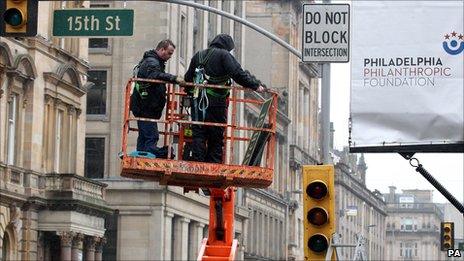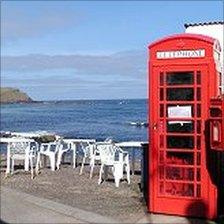Big screen hopes for Scottish economy
- Published

Hundreds of people are working in Glasgow as part of the city is transformed into an American set for the Brad Pitt movie
The big screen looks set to give Scotland's economy a shot in the arm.
Filming started in Glasgow this week for a zombie movie starring Brad Pitt.
The city council has estimated production on World War Z could rake in more than £2m for the local economy.
And tourism bosses are hoping other blockbusters in the pipeline could boost the phenomenon known as "set-jetting" - tourists who visit places purely to see locations used in film and TV productions.
World War Z has come at a welcome time for those attempting to keep Scotland firmly on the movie map.
Location spend north of the border actually fell last year from £25m in 2009 to £21.5m.
Creative Scotland - the agency charged with maximising the economic benefits of filming - said the fall came despite a rise in the number of films made.
Location department manager Belle Doyle explained: "The amount being spent directly on location - crew facilities, car hire, hotels and so on - was actually growing up until last year.
"However, although we had a lot of filming, it tended to be quite low budget."
Blockbusters
Tourism body VisitScotland is pinning its hopes on several forthcoming blockbusters - including one that was neither produced nor filmed in Scotland.
Brave, a 3D computer-animated fantasy adventure film made by Disney/Pixar, is set in the Highlands and features the voices of top actors such as Billy Connolly, Emma Thomson, Robbie Coltrane and Julie Walters.

Pennan still draws tourists to the phone box featured in Local Hero
VisitScotland believe the film, which is due for release next year, could well generate huge interest in Scotland from fans around the world.
Film tourism project manager Jenni Steele said: "We are really hopeful that Brave does inspire a lot of people around the world to see Scotland.
"Although it is an animated magical story, magic, myths and legends are something Scotland is really well known for.
"Scotland is not too far away from that magical world, with our mountains and lakes, forests and valleys and rivers. We hope Brave will inspire them to see what Scotland is really like."
Other Hollywood films on the horizon with a Scottish link include Cloud Atlas, a new Tom Hanks and Halle Berry vehicle which has been partly shot in Glasgow, Edinburgh and Bo'ness.
And a Scarlett Johansson film - Under the Skin - is expected to show scenes from the Highlands.
Economic benefits
The direct economic benefits to Scotland from filming can be considerable, according to Creative Scotland.
It estimates a film like World War Z, which involves a production crew in the hundreds, can bring in a daily spend of £30,000 on hotels, car hire and other production costs.
Belle Doyle commented: "We don't want the crews to come just for a few days - we'd like them to stay as long as possible. What you want is 300 people here spending money."
Ms Doyle said being able to accommodate big-budget movies has encouraged others to see Scotland as a suitable location.
She added: "Every time we get something big here, the more it says Scotland can do it and facilitate a production, whatever its size - and that is a great thing to be able to say."
Set-jetting has proved to be a "good by-product" of Creative Scotland's drive to attract film makers to Scotland, according to Ms Doyle.
Examples of films which boosted local economies include the 1995 epic Braveheart, starring Mel Gibson.
Before the film was released, the Wallace Monument in Stirling drew 30,000 to 40,000 people a year - in 1996, nearly 200,000 people visited.
Rosslyn Chapel also saw tourist figures leap after the release of the Da Vinci Code, with visitor numbers rising from 118,000 in 2005 to 175,000 the following year.
And Pennan in Aberdeenshire still draws tourists to see a replica of a prop phone box featured in Local Hero from 1983.
'Bread and butter'
However, while Hollywood blockbusters have helped raise Scotland's profile, Ms Doyle pointed out that "bread and butter" projects have in the past accounted for the majority of annual location spend.
She added: "Out of £25m, £20m is probably the run-of-the-mill stuff that no one ever thinks about - stills shoots and commercials, for example."
Some commercials can also be big business.

The cult film Wicker Man sparked an annual festival in Galloway
Sony's high-definition Bravia television advertisement, which showed thousands of litres of paint exploding onto a block of flats in Glasgow in 2006, is thought to have attracted a location spend of up to £1m.
Agencies such as Creative Scotland are hoping the weakness of the pound will encourage more overseas production companies to bring their business here.
That would come as a welcome boost for Dumfries and Galloway, where the 1973 cult horror film The Wicker Man was shot.
A legacy of the film was the creation of the annual Wickerman Festival in Kirkcudbright which has drawn an estimated 100,000 visitors over the past decade.
But recent location spend in the region has proved less successful - falling sharply last year from almost £920,000 in 2009 to just £778,000.
The local council said it had seen more filming but less spending by production firms.
'Movie map'
A council spokesman said: "This demonstrates that while still achieving an increase in inquiries and number of projects filming, it is becoming harder to maintain a high level of spend in the region during the current economic climate."
It has been working closely with VisitScotland to develop a regional "movie map" in order to draw more visitors to the region.
Ms Doyle said: "When a film or TV drama or commercial is made, it can benefit local cafes, B&Bs and other businesses and this can have a big impact on a local economy.
"We would always want the local community to benefit in some way."
VisitScotland, meanwhile, is continuing to keep movies sharply in focus.
Ms Steele commented: "Films provide a fantastic advertising opportunity. Even if only a percentage of tourists are coming here on the back of a film, it is significant.
"If we can tap into that audience it is an additional opportunity to try to get them to come to Scotland."
- Published15 August 2011
- Published27 June 2011
- Published3 August 2011
- Published9 July 2011
- Published17 June 2011
- Published25 July 2011